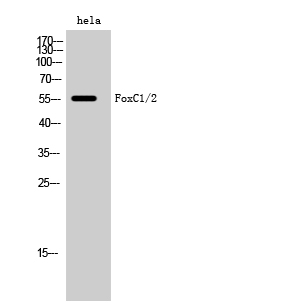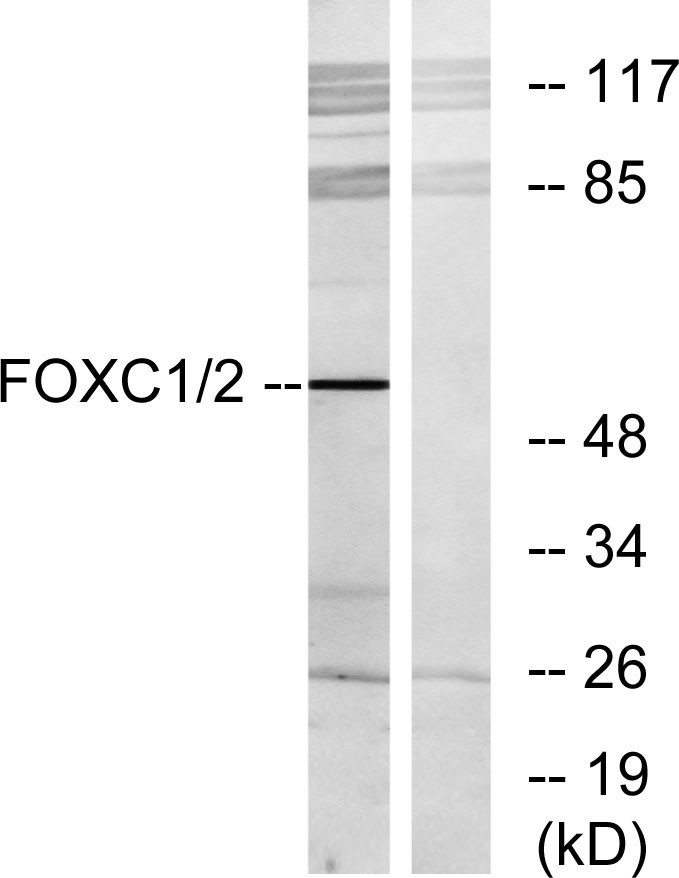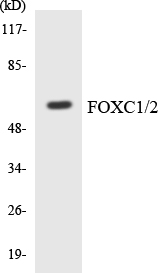FoxC1/2 Polyclonal Antibody
- Catalog No.:YT1742
- Applications:WB;IHC;IF;ELISA
- Reactivity:Human;Mouse;Rat
- Target:
- FoxC1/2
- Gene Name:
- FOXC1/FOXC2
- Protein Name:
- Forkhead box protein C1/2
- Human Gene Id:
- 2296/2303
- Human Swiss Prot No:
- Q12948/Q99958
- Mouse Gene Id:
- 17300/14234
- Rat Swiss Prot No:
- Q63246
- Immunogen:
- The antiserum was produced against synthesized peptide derived from human FOXC1/2. AA range:151-200
- Specificity:
- FoxC1/2 Polyclonal Antibody detects endogenous levels of FoxC1/2 protein.
- Formulation:
- Liquid in PBS containing 50% glycerol, 0.5% BSA and 0.02% sodium azide.
- Source:
- Polyclonal, Rabbit,IgG
- Dilution:
- WB 1:500 - 1:2000. IHC 1:100 - 1:300. IF 1:200 - 1:1000. ELISA: 1:40000. Not yet tested in other applications.
- Purification:
- The antibody was affinity-purified from rabbit antiserum by affinity-chromatography using epitope-specific immunogen.
- Concentration:
- 1 mg/ml
- Storage Stability:
- -15°C to -25°C/1 year(Do not lower than -25°C)
- Other Name:
- FOXC1;FKHL7;FREAC3;Forkhead box protein C1;Forkhead-related protein FKHL7;Forkhead-related transcription factor 3;FREAC-3;FOXC2;FKHL14;MFH1;Forkhead box protein C2;Forkhead-related protein FKHL14;Mesenchyme fork head protein 1;
- Observed Band(KD):
- 57kD
- Background:
- This gene belongs to the forkhead family of transcription factors which is characterized by a distinct DNA-binding forkhead domain. The specific function of this gene has not yet been determined; however, it has been shown to play a role in the regulation of embryonic and ocular development. Mutations in this gene cause various glaucoma phenotypes including primary congenital glaucoma, autosomal dominant iridogoniodysgenesis anomaly, and Axenfeld-Rieger anomaly. [provided by RefSeq, Jul 2008],
- Function:
- disease:Defects in FOXC1 are a cause of Axenfeld-Rieger syndrome (ARS) [MIM:601090]; also known as Axenfeld syndrome or Axenfeld anomaly. It is characterized by posterior corneal embryotoxon, prominent Schwalbe line and iris adhesion to the Schwalbe line. Other features may be hypertelorism (wide spacing of the eyes), hypoplasia of the malar bones, congenital absence of some teeth and mental retardation. When associated with tooth anomalies, the disorder is known as Rieger syndrome. Glaucoma is a progressive blinding condition that occurs in approximately half of patients with Axenfeld-Rieger malformations.,disease:Defects in FOXC1 are a cause of Peters anomaly [MIM:604229]. Peters anomaly consists of a central corneal leukoma, absence of the posterior corneal stroma and Descemet membrane, and a variable degree of iris and lenticular attachments to the central aspect of the posterior cor
- Subcellular Location:
- Nucleus . Colocalizes with PITX2 isoform 3 in the nucleus at subnuclear chromatine regions (PubMed:16449236). Colocalizes with CBX5 to a heterochromatin-rich region of the nucleus (PubMed:15684392). Colocalizes with GLI2 in the nucleus (By similarity). .
- Expression:
- Expressed in keratinocytes of epidermis and hair follicle (PubMed:27907090). Expressed strongly in microvascular invasion (MVI) formation, basal-like breast cancer (BLBC) and hepatocellular tumors (PubMed:20406990, PubMed:22991501). Expressed in breast cancers (at protein level) (PubMed:26565916). Expressed in hematopoietic cells (PubMed:8499623).
- June 19-2018
- WESTERN IMMUNOBLOTTING PROTOCOL
- June 19-2018
- IMMUNOHISTOCHEMISTRY-PARAFFIN PROTOCOL
- June 19-2018
- IMMUNOFLUORESCENCE PROTOCOL
- September 08-2020
- FLOW-CYTOMEYRT-PROTOCOL
- May 20-2022
- Cell-Based ELISA│解您多样本WB检测之困扰
- July 13-2018
- CELL-BASED-ELISA-PROTOCOL-FOR-ACETYL-PROTEIN
- July 13-2018
- CELL-BASED-ELISA-PROTOCOL-FOR-PHOSPHO-PROTEIN
- July 13-2018
- Antibody-FAQs
- Products Images

- Western Blot analysis of hela cells using FoxC1/2 Polyclonal Antibody diluted at 1:2000 cells nucleus extracted by Minute TM Cytoplasmic and Nuclear Fractionation kit (SC-003,Inventbiotech,MN,USA).

- Western blot analysis of lysates from RAW264.7 cells, using FOXC1/2 Antibody. The lane on the right is blocked with the synthesized peptide.

- Western blot analysis of the lysates from Jurkat cells using FOXC1/2 antibody.

- Immunohistochemical analysis of paraffin-embedded human tonsil. 1, Tris-EDTA,pH9.0 was used for antigen retrieval. 2 Antibody was diluted at 1:200(4° overnight.3,Secondary antibody was diluted at 1:200(room temperature, 45min).



